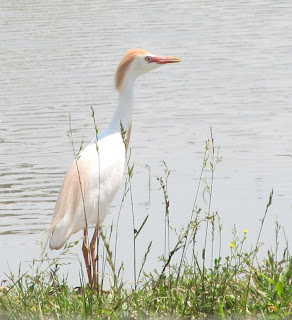I have saw these birds yesterday on Jerry Norris' pond at the top of Meek Hill. There is about 6 of them. They are about a foot tall when they stretch out their necks. I think they are young birds and not adults. I have never seen anything like this around here. Today, when I saw them again, I drove back with my camera for pictures. What kind of birds are they?





3 comments:
egret? Patsy will tell us.
I am back in business so I will be going to our war record site..
aren't they just cranes....h
The Cattle Egret is a stocky heron with a 88–96 cm (35–38 in) wingspan; it is 46–56 centimetres (18–22 in) long and weighs 270–512 grams (9.5–18.1 oz).[12] It has a relatively short thick neck, sturdy bill, and a hunched posture. The non-breeding adult has mainly white plumage, a yellow bill and greyish-yellow legs. During the breeding season, adults of the nominate western subspecies develop orange-buff plumes on the back, breast and crown, and the bill, legs and irises become bright red for a brief period prior to pairing.[13] The sexes are similar, but the male is marginally larger and has slightly longer breeding plumes than the female; juvenile birds lack coloured plumes and have a black bill.[12][14]
B. i. coromandus differs from the nominate subspecies in breeding plumage, when the buff colour on its head extends to the cheeks and throat, and the plumes are more golden in colour. This subspecies' bill and tarsus are longer on average than in B. i. ibis.[15] B. i. seychellarum is smaller and shorter-winged than the other forms. It has white cheeks and throat, like B. i. ibis, but the nuptial plumes are golden, as with B. i. coromandus.[9]
The positioning of the egret's eyes allows for binocular vision during feeding,[16] and physiological studies suggest that the species may be capable of crepuscular or nocturnal activity.[17] Adapted to foraging on land, they have lost the ability possessed by their wetland relatives to accurately correct for light refraction by water.[18]
This species gives a quiet, throaty "rick-rack" call at the breeding colony, but is otherwise largely silent.[19]
Post a Comment